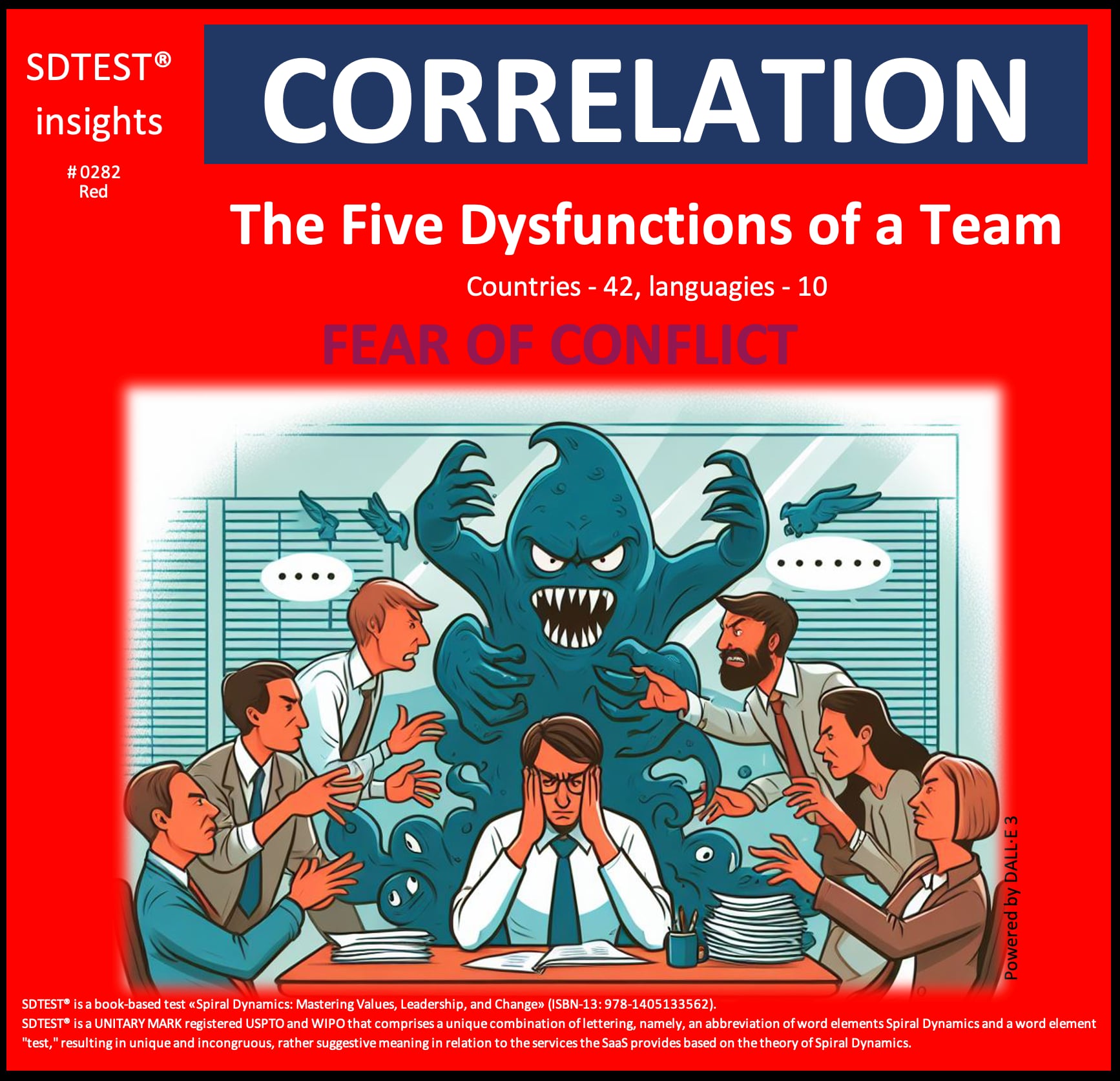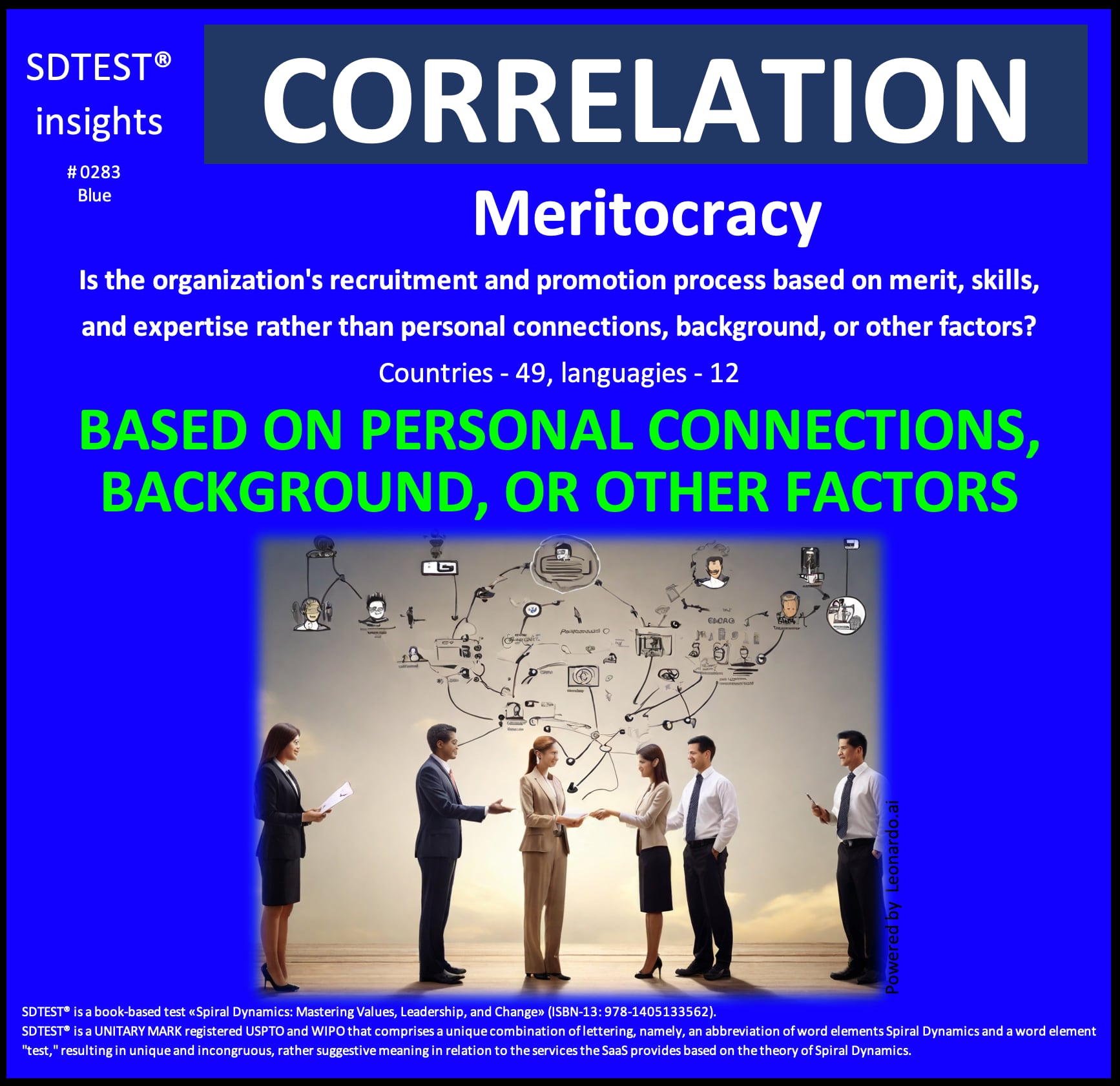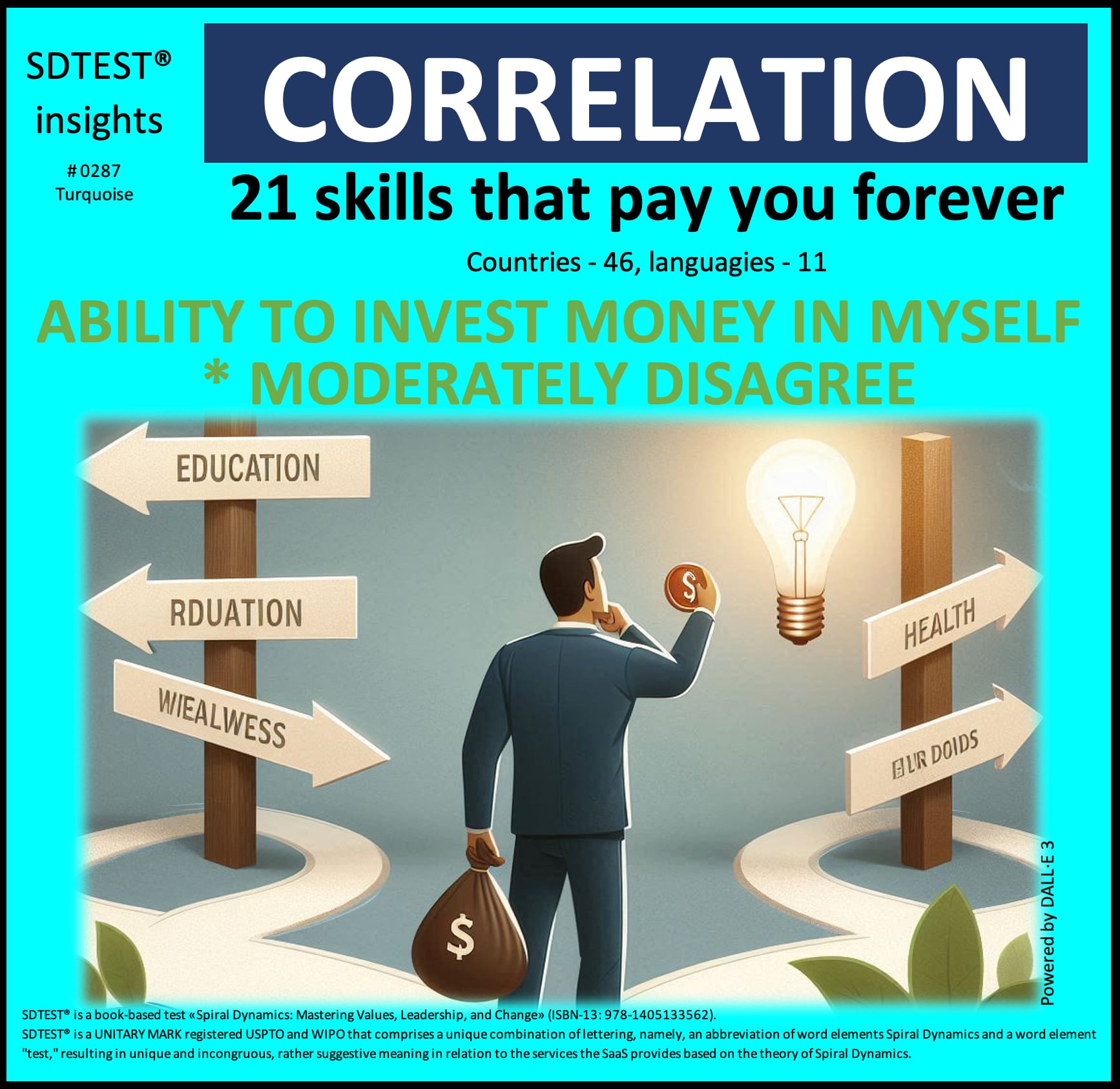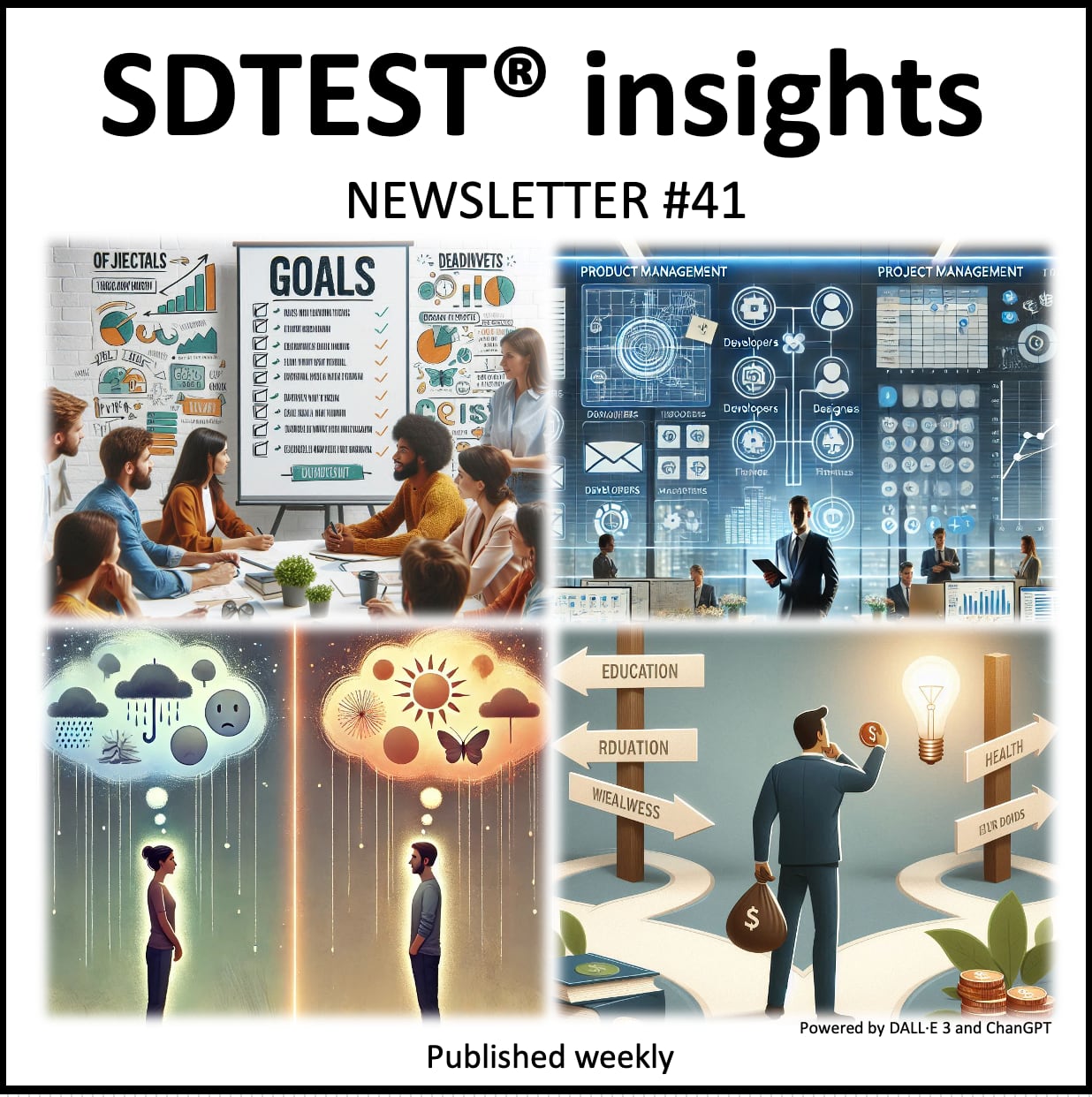SDTEST® has 36 different VUCA polls that calculate the 13,034 correlation values between stages of development according to the theory of Spiral Dynamics and answer options of these 36 polls.
We invite curiosity about the systemic mechanisms behind this correlation. There may be hidden variables that provide alternative explanations.
In our analysis of the poll "XING's culture assessment" (Leadership. Imagine the perfect people manager. What do you expect from them?), we found an intriguing negative correlation that warrants closer examination:
-0.1721 between the They involve me when setting goals and the Purple stage.
The critical value of the correlation coefficient for a normal distribution, by William Sealy Gosset (Student) r = 0.163. This negative correlation of -0.1721 meets the reliability criteria but does not necessarily imply causation.

This negative correlation of -0.1721 between involving individuals in goal-setting and the Purple stage offers intriguing insights when viewed through the lens of the Purple value system:
Organizational Perspective:
Organizations operating within the Purple mindset might interpret this correlation as:
- Validation of their hierarchical structure and the wisdom of traditional leadership.
- Confirmation of the importance of maintaining established rituals and practices in goal-setting.
- Evidence supporting the role of spiritual or ancestral guidance in organizational direction.
These organizations might respond by:
- Reinforcing the authority of respected elders or leaders in setting goals for the group.
- Implementing goal-setting rituals that invoke spiritual or ancestral wisdom.
- Emphasizing the importance of collective acceptance of goals set by revered leaders.
Team Perspective:
Teams operating from a Purple mindset might approach this correlation by:
- Viewing it as an affirmation of their trust in the team leader's connection to higher wisdom.
- Interpreting it as support for maintaining group harmony through unified acceptance of goals.
- Seeing it as validation for prioritizing team cohesion over individual input in goal-setting.
These teams might respond by:
- Developing ceremonies to mark the acceptance of goals set by leadership.
- Encouraging team members to seek spiritual or ancestral guidance to align with set goals.
- Fostering a sense of shared destiny and collective purpose around established goals.
Individual Perspective:
Individuals aligned with the Purple value system might interpret this correlation as:
- Personal validation of their trust in the wisdom of leaders and traditions.
- Evidence supports their belief in collective harmony's importance over individual input.
- Confirmation of the value they place on spiritual or ancestral guidance in life direction.
These individuals might respond by:
- Seeking spiritual or traditional rituals to align themselves with organizational goals better.
- Deriving a sense of security and belonging from accepting goals set by respected leaders.
- Actively participating in group ceremonies that reinforce collective commitment to set goals.
This correlation, viewed through the Purple lens, suggests that those operating at the Purple level may be less likely to expect or desire involvement in goal-setting processes. It implies that the Purple value system's characteristics of respect for tradition, belief in spiritual guidance, and focus on group harmony align with a more top-down approach to goal-setting.
The reasons why not involving individuals in goal-setting might be seen as characteristic of a "perfect people manager" in the Purple stage could include:
- Respect for Authority: The Purple stage highly values the wisdom and authority of leaders, potentially seeing their sole involvement in goal-setting as ideal.
- Spiritual Guidance: Some may believe goals should be set through spiritual or ancestral guidance rather than individual input.
- Maintaining Harmony: Involving individuals in goal-setting might be seen as potentially disruptive to group harmony and unity.
- Tradition and Ritual: Goal-setting may be viewed as a sacred process best left to those in traditional leadership roles.
- Collective Identity: The strong sense of group identity in the Purple stage may prioritize collective acceptance over individual involvement.
This correlation makes us consider how different value systems influence perceptions of effective leadership and goal-setting processes. It raises questions about the potential benefits and challenges of a Purple approach to organizational management, particularly in contexts where individual input and innovation are crucial.
Ultimately, this correlation highlights the complex interplay between cultural values, leadership styles, and organizational practices. It suggests that effective people management in Purple-dominant environments may be more closely tied to upholding traditions, maintaining group harmony, and channeling spiritual or ancestral wisdom than involving individuals in decision-making processes.
In our analysis of the poll "The Five Dysfunctions of a Team" (Patrick Lencioni [1]), we found an intriguing negative correlation that warrants closer examination:
-0.1584 between the Fear of Conflict (Healthy debates are pivotal for any team. Avoiding conflict leads to passive aggression and unresolved issues) and the Red stage.
The critical value of the correlation coefficient for a normal distribution, by William Sealy Gosset (Student) r = 0.1285. This negative correlation of -0.1584 meets the reliability criteria but does not necessarily imply causation.

This negative correlation of -0.1584 between Fear of Conflict as a team dysfunction and the Red stage offers intriguing insights when viewed through the lens of the Red value system:
Organizational Perspective:
Organizations operating within the Red mindset might interpret this correlation as:
- Validation of their aggressive, power-driven approach to problem-solving and decision-making.
- Confirmation that their competitive, confrontational culture drives results and eliminates weakness.
- Evidence supporting their belief that conflict is a natural and necessary part of organizational dynamics.
These organizations might respond by:
- Encouraging more confrontations and power plays as a means of resolving issues.
- Implement reward systems that favor those who forcefully assert themselves in conflicts.
- Promoting leaders who can dominate and win in confrontational situations.
Team Perspective:
Teams operating from a Red mindset might approach this correlation by:
- Viewing it as an affirmation of their aggressive, competitive team dynamic.
- Interpreting it supports their belief that conflict weeds out the weak and ineffective team members.
- Seeing it as validation for prioritizing immediate, forceful resolution of disagreements over long-term harmony.
These teams might respond by:
- Staging more frequent confrontational meetings to address issues head-on.
- Encouraging team members to assert their dominance and fight for their ideas.
- Celebrating instances of conflict as demonstrations of passion and commitment to the team's goals.
Individual Perspective:
Individuals aligned with the Red value system might interpret this correlation as:
- Personal validation of their aggressive and assertive approach to teamwork.
- Evidence supporting their belief that showing strength through conflict is vital to success.
- Confirmation of the value they place on immediate gratification and self-expression in team settings.
These individuals might respond by:
- Actively seeking out opportunities for conflict to assert their dominance.
- Viewing their willingness to confront as a strength and competitive advantage.
- Using conflicts to climb the hierarchy and gain more power within the team or organization.
This correlation, viewed through the Red lens, suggests that those operating at the Red level may be less likely to fear conflict within teams. It implies that the Red value system's assertiveness, competitiveness, and focus on immediate gratification align with a more aggressive approach to team dynamics.
The reasons why Fear of Conflict might not be seen as a dysfunction of a team in the Red stage could include:
- Conflict as Strength: In the Red stage, conflict might be viewed as a sign of strength and engagement rather than a problem to be avoided.
- Power Dynamics: Conflict could be seen as a necessary means of establishing and maintaining power hierarchies within the team
- Immediate Resolution: The Red stage's focus on immediate gratification may favor quick, confrontational resolution of issues over long-term, diplomatic approaches.
- Self-Expression: Conflict might be viewed as a valid form of self-expression and asserting one's individuality within the team.
- Competitive Advantage: Engaging in conflict could be seen as a way to gain a competitive advantage and prove one's worth to the team.
This correlation prompts us to consider how different value systems influence perceptions of healthy team dynamics. It raises questions about the potential benefits and drawbacks of a Red approach to conflict within teams, particularly in contexts where long-term collaboration and complex problem-solving are crucial.
Ultimately, this correlation highlights the complex interplay between cultural values, team dynamics, and organizational effectiveness. It suggests that conflict might be seen not as a dysfunction but as a natural and even desirable aspect of team interactions in Red-dominant environments.
In our analysis of the poll "Meritocracy," we found an intriguing positive correlation that warrants closer examination:
0.1357 between the Organisation's recruitment and promotion process based on personal connections, background, or other factors and the Blue stage.
The critical value of the correlation coefficient for a normal distribution, by William Sealy Gosset (Student) r = 0.1226. This positive correlation of 0.1357 meets the reliability criteria but does not necessarily imply causation.

This positive correlation of 0.1357 between recruitment and promotion processes based on personal connections, background, or other factors and the Blue stage offers intriguing insights when viewed through the lens of the Blue value system:
Organizational Perspective:
Organizations operating within the Blue mindset might interpret this correlation as:
- Validation of their traditional approach to staffing, emphasizing loyalty and cultural fit.
- Confirmation that their hierarchical structure and respect for authority extend to hiring practices.
- Evidence supports their belief in the importance of maintaining organizational values and traditions through careful personnel selection.
These organizations might respond by:
- Formalizing processes prioritizing candidates with connections to existing employees or similar backgrounds.
- Implementing strict vetting procedures to ensure new hires align with the organization's moral code and traditions.
- Emphasizing long-term commitment and loyalty in recruitment and promotion criteria.
Team Perspective:
Teams operating from a Blue mindset might approach this correlation by:
- Viewing it as an affirmation of the importance of team cohesion and shared values.
- Interpreting it as support for maintaining team stability through familiar additions.
- Seeing it as validation for prioritizing loyalty and cultural fit in team expansion.
These teams might respond by:
- Encouraging team members to recommend candidates from their networks who share similar values.
- Developing team-specific traditions and rituals to reinforce the importance of cultural alignment.
- Advocating for promoting long-standing team members who have demonstrated loyalty and adherence to team norms.
Individual Perspective:
Individuals aligned with the Blue value system might interpret this correlation as:
- Personal validation of the importance of building strong organizational relationships.
- Evidence supports their belief in loyalty's value and long-term commitment to an organization.
- Confirmation of the role of personal character and background in professional advancement.
These individuals might respond by:
- Actively seeking to build connections within the organization and align themselves with its values.
- Focusing on demonstrating loyalty and adherence to organizational norms as a path to advancement.
- Viewing their background and connections as valuable assets in their professional journey.
This correlation, viewed through the Blue lens, suggests that those operating at the Blue level may be more likely to accept or even prefer recruitment and promotion processes based on personal connections, background, or other factors beyond mere merit. It implies that the Blue value system's characteristics of tradition, loyalty, and adherence to established norms align with a more relationship-based approach to staffing decisions.
The reasons why recruitment and promotion based on personal connections or background might be prevalent in the Blue stage could include:
- Emphasis on Tradition: The Blue stage values continuity and tradition, which may extend to maintaining familiar networks within the organization.
- Loyalty and Trust: Personal connections may be seen as indicators of loyalty and trustworthiness, key values in the Blue system.
- Cultural Preservation: Hiring those with similar backgrounds may be viewed as a way to preserve organizational culture and values.
- Hierarchical Respect: Connections to respected figures within the organization may be seen as endorsements of a candidate's character.
- Moral Alignment: Personal background might be used as a proxy for assessing alignment with the organization's moral code.
This correlation prompts us to consider how value systems influence human resource practices. It raises questions about the balance between maintaining organizational culture and ensuring diversity and meritocracy. It also invites scrutiny of how this approach might impact organizational adaptability and innovation.
Ultimately, this correlation highlights the complex interplay between cultural values, organizational practices, and staffing decisions. It suggests that recruitment and promotion processes in Blue-dominant environments may prioritize factors that ensure continuity, loyalty, and cultural fit alongside or above pure merit-based criteria.
In our analysis of the poll "I live thinking about my past, present or future," we found an intriguing negative correlation that warrants closer examination:
-0.0821 between the Past and the Orange stage.
The critical value of the correlation coefficient for a normal distribution, by William Sealy Gosset (Student) r = 0.0585. This negative correlation of -0.0821 meets the reliability criteria but does not necessarily imply causation.

This negative correlation of -0.0821 between past-oriented thinking and the Orange stage offers intriguing insights when viewed through the lens of the Orange value system:
Organizational Perspective:
Organizations operating within the Orange mindset might interpret this correlation as:
- Validation of their future-focused, goal-oriented approach to strategy and operations.
- Confirmation that their emphasis on innovation and progress drives results and eliminates inefficiencies.
- Evidence supporting their belief that forward-thinking is crucial for organizational success and competitiveness.
These organizations might respond by:
- Implementing more data-driven forecasting and predictive analytics tools.
- Designing reward systems that favor those who propose innovative solutions and drive measurable progress.
- Promoting leaders who demonstrate a strong vision for the future and the ability to adapt to changing market conditions.
Team Perspective:
Teams operating from an Orange mindset might approach this correlation by:
- Viewing it as an affirmation of their results-driven, efficiency-focused team dynamic.
- Interpreting it supports their belief that dwelling on past experiences hinders innovation and growth.
- Seeing it as validation for prioritizing measurable outcomes and future potential over historical precedents.
These teams might respond by:
- Conduct frequent strategy sessions focused on future market trends and technological advancements.
- Encouraging team members to propose innovative ideas and challenge status quo thinking.
- Celebrating instances of breakthrough innovations and successful adaptations to change.
Individual Perspective:
Individuals aligned with the Orange value system might interpret this correlation as:
- Personal validation of their ambitious and forward-thinking approach to career development.
- Evidence supporting their belief that continuous self-improvement and skill acquisition are vital to success.
- Confirmation of the value they place on rational decision-making and evidence-based problem-solving.
These individuals might respond by:
- Actively seeking out opportunities for professional development and acquiring new technological skills.
- Viewing their ability to adapt quickly to change as a strength and competitive advantage.
- Using data-driven metrics to track personal performance and set ambitious future goals.
This correlation, viewed through the Orange lens, suggests that those operating at the Orange level may be less likely to dwell on past experiences. It implies that the Orange value system's focus on progress, efficiency, and future-oriented thinking aligns with a more forward-looking personal and professional development approach.
The reasons why individuals in the Orange stage might not be thinking about their past could include:
- Future Focus: In the Orange stage, the future is seen as the primary source of opportunities and growth rather than the past.
- Efficiency Mindset: Dwelling on the past might be considered an inefficient use of time and mental resources.
- Rapid Adaptation: The Orange stage's emphasis on adapting to change may favor looking ahead rather than reflecting on past events.
- Measurable Progress: Past experiences are valued primarily as data points for analysis, not as guiding principles for decision-making.
- Innovation Drive: Focusing on the past may hinder innovative thinking and problem-solving.
This correlation prompts us to consider how different value systems influence perceptions of time orientation and its impact on personal and organizational success. It raises questions about the potential benefits and drawbacks of an Orange approach to temporal focus, particularly in contexts where learning from historical data and maintaining institutional knowledge are crucial.
Ultimately, this correlation highlights the complex interplay between cultural values, cognitive processes, and organizational effectiveness. Past-oriented thinking might be seen not as a valuable reflection tool but as a potential obstacle to progress and innovation in Orange-dominant environments.
0.2665 between the IT job specialty - Management (product, project, etc) and the Green stage.
The critical value of the correlation coefficient for a normal distribution, by William Sealy Gosset (Student) r = 0.2212. This positive correlation of 0.2665 meets the reliability criteria but does not necessarily imply causation.

This positive correlation of 0.2665 between IT job specialty - Management (product, project, etc.) and the Green stage offers intriguing insights when viewed through the lens of the Green value system:
Organizational Perspective:
Organizations operating within the Green mindset might interpret this correlation as:
- Validation of their holistic, systems-thinking approach to IT project management.
- Confirmation that their emphasis on collaborative leadership and inclusive decision-making attracts management-oriented IT professionals.
- Evidence supporting their belief that sustainable, socially responsible IT practices require strong, values-aligned management.
These organizations might respond by:
- Implementing more collaborative and participatory management methodologies.
- Designing recruitment strategies that emphasize the organization's commitment to social responsibility and sustainability in IT.
- Promoting leaders who demonstrate strong emotional intelligence and ability to foster inclusive, diverse teams.
Team Perspective:
Teams operating from a Green mindset might approach this correlation by:
- Viewing it as an affirmation of their community-oriented, consensus-driven team dynamic.
- Interpreting it supports their belief that effective IT management requires a holistic understanding of human and environmental impacts.
- Seeing it as validation for prioritizing team well-being and work-life balance in IT project management.
These teams might respond by:
- Conducting more frequent team-building exercises focused on shared values and collective growth.
- Encouraging team members to rotate through management roles to foster empathy and systems thinking.
- Celebrating instances of successful stakeholder engagement and community-beneficial IT solutions.
Individual Perspective:
Individuals aligned with the Green value system might interpret this correlation as:
- Personal validation of their desire to make a positive impact through IT management roles.
- Evidence supporting their belief that effective IT leadership requires empathy, emotional intelligence, and a holistic worldview.
- Confirmation of the value they place on facilitating collaboration and nurturing team potential.
These individuals might respond by:
- Actively seeking out management roles that allow them to align IT projects with broader social and environmental goals.
- Viewing their ability to foster inclusive, diverse teams as a key strength in IT management.
- Using their management position to advocate for more sustainable and ethically responsible IT practices.
This correlation, viewed through the Green lens, suggests that those operating at the Green level may be more drawn to management roles in IT. It implies that the Green value system's focus on community, ecology, and holistic thinking aligns well with the complex, people-oriented nature of IT project and product management.
The reasons why IT job specialty - Management might be particularly critical in the Green stage for IT specialists in choosing a job offer could include:
- Systemic Impact: Management roles allow IT professionals to influence entire systems and foster organizational change aligned with Green values.
- Collaborative Leadership: Green-oriented individuals may see management as an opportunity to implement more participatory, consensus-driven leadership styles in IT.
- Stakeholder Engagement: IT management roles often involve extensive stakeholder management, aligning with the Green emphasis on community and inclusivity.
- Ethical Responsibility: Management positions provide a platform to ensure IT projects consider their broader social and environmental impacts.
- Holistic Problem-Solving: IT management requires considering diverse perspectives and complex interdependencies, resonating with Green systems thinking.
This correlation prompts us to consider how different value systems influence career preferences in the IT field. It raises questions about the potential benefits of a Green approach to IT management, particularly when technology's societal and environmental impacts are increasingly scrutinized.
Ultimately, this correlation highlights the complex interplay between cultural values, career choices, and technological development. IT management roles might be seen as critical avenues for enacting positive change and fostering more sustainable, community-oriented technological progress in Green-dominant environments.
In our analysis of the poll "Empathy is," we found an intriguing negative correlation that warrants closer examination:
-0.2012 between the Imagining how someones is feeling / Strongly Disagree and the Yellow stage.
The critical value of the correlation coefficient for a normal distribution, by William Sealy Gosset (Student) r = 0.0703. This negative correlation of -0.2012 meets the reliability criteria but does not necessarily imply causation.

This negative correlation of -0.2012 between strongly disagreeing that "Empathy is imagining how someone is feeling" and the Yellow stage, when accounting for the double negation, suggests that those in the Yellow stage tend to agree that empathy involves imagining how someone is feeling. This offers intriguing insights when viewed through the lens of the Yellow value system:
Organizational Perspective:
Companies at this level might interpret this correlation as:
- Validation of their integrative approach that recognizes imagination as a crucial component of empathy while still holding space for other aspects.
- Confirmation that their emphasis on cognitive flexibility allows for embracing imagination as a tool for empathy without discarding other methods.
- Evidence supports their belief in the power of mental simulation as part of a holistic approach to understanding others.
These companies might respond by:
- Implementing empathy training programs that emphasize imaginative exercises alongside other empathy-building techniques.
- Design work processes that encourage employees to use their imaginations to better understand colleagues, customers, and stakeholders.
- Promoting leaders who can effectively use and teach imaginative empathy as part of a broader emotional intelligence toolkit.
Team Perspective:
Teams at this level might approach this correlation by:
- Viewing it as an affirmation of the value of imaginative exercises in building team cohesion and understanding.
- Interpreting it as support for incorporating imagination-based activities into their empathy-building practices.
- Seeing it as validation for balancing imaginative perspective-taking with other emotional connection forms.
These teams might respond by:
- Engaging in more scenario-based exercises, encouraging members to imagine themselves in others' positions.
- Encouraging team members to use their imagination to bridge gaps in understanding, especially in diverse teams.
- Celebrating instances where imaginative empathy leads to breakthrough insights or improved team dynamics.
Individual Perspective:
Individuals aligned with the Yellow value system might interpret this correlation as:
- Personal validation of their ability to use imagination as a powerful tool for empathy while recognizing its place within a broader empathetic approach.
- Evidence supporting their belief in the importance of mental flexibility and creativity in understanding others.
- Confirmation of the value they place on cognitive empathy alongside other forms of emotional connection.
These individuals might respond by:
- Actively honing their ability to imagine others' perspectives as part of their empathy toolkit.
- Viewing their capacity for imaginative empathy as a strength while continuing to develop other aspects of emotional intelligence.
- Using their imaginative skills to enhance their understanding of complex social systems and individual experiences.
This correlation, viewed through the Yellow lens, suggests that those operating at the Yellow level recognize the value of imagination in empathy. It implies that the Yellow value system's focus on integration and multiple perspectives allows for embracing imagination as a key component of empathy while still holding space for other aspects.
The reasons why individuals in the Yellow stage might agree that empathy involves imagining how someone is feeling could include the following:
- Cognitive Flexibility: Yellow thinkers can appreciate the role of imagination in empathy without being limited to it.
- Integrative Thinking: They can see how imagination complements other aspects of empathy, creating a more holistic approach.
- Systems Perspective: Imagination allows them to simulate complex systems of experience, aiding in understanding others.
- Transcendence of Dichotomies: They can hold that empathy involves both imagination and direct experience, transcending an either/or mentality.
- Recognition of Mental Simulation: Yellow thinkers appreciate the power of mental simulation in understanding others' experiences.
This correlation prompts us to consider how different value systems influence our understanding of empathy. It raises questions about the role of imagination in emotional intelligence and how it can be balanced with other empathetic approaches.
Ultimately, this correlation highlights the nuanced view of empathy in Yellow-dominant environments. Empathy is a multi-faceted process that includes imagination while leaving room for other forms of emotional connection and understanding within complex human systems.
In our analysis of the poll "21 skills that pay you forever" (by Jeremiah Teo / 赵汉昇 [2]), we found an intriguing positive correlation that warrants closer examination:
0.2017 between the Ability to invest money in myself / Moderately Disagree and the Turquoise stage.
The critical value of the correlation coefficient for a normal distribution, by William Sealy Gosset (Student) r = 0.1519. This positive correlation of 0.2017 meets the reliability criteria but does not necessarily imply causation.

This positive correlation of 0.2017 between moderately disagreeing that "Ability to invest money in myself" is a skill that pays forever and the Turquoise stage offers intriguing insights when viewed through the lens of the Turquoise value system:
Organizational Perspective:
Companies at this level might interpret this correlation as:
- Validation of their holistic approach that values collective well-being over individual financial gain.
- Confirmation that their emphasis on interconnectedness and sustainability transcends traditional notions of personal investment.
- Evidence supporting their belief that true value lies in investing in the broader ecosystem rather than solely in oneself.
These companies might respond by:
- Implementing policies encouraging employees to invest in community and environmental initiatives rather than solely personal development.
- Designing reward systems that recognize contributions to collective well-being and planetary health.
- Promoting leaders who commit to holistic, systemic thinking beyond personal financial growth.
Team Perspective:
Teams at this level might approach this correlation by:
- Viewing it affirms their focus on collective growth and synergistic development.
- Interpreting it as support for prioritizing team and ecosystem investments over individual financial gains.
- Seeing it as validation for their belief in the interconnectedness of all team members and their environment.
These teams might respond by:
- Engaging in more collaborative projects that benefit the broader community or environment.
- Encouraging team members to invest their resources (time, money, skills) in ways that enhance the entire ecosystem.
- Celebrating instances where collective investment leads to sustainable, holistic improvements for all stakeholders.
Individual Perspective:
Individuals aligned with the Turquoise value system might interpret this correlation as:
- Personal validation of their belief that true wealth comes from investing in the well-being of all, not just oneself.
- Evidence supporting their intuition that personal financial investment is limited in its ability to create lasting, meaningful change.
- Confirmation of the value they place on holistic, systemic thinking over individualistic financial strategies.
These individuals might respond by:
- Actively seeking opportunities to invest their resources in ways that benefit the broader ecosystem.
- Viewing their ability to consider investments' long-term, systemic impacts as a key strength.
- Using their resources to foster interconnectedness and promote sustainable, harmonious living for all.
This correlation, viewed through the Turquoise lens, suggests that those operating at the Turquoise level are skeptical that personal financial investment is a skill that "pays forever." It implies that the Turquoise value system's focus on holistic thinking and interconnectedness leads to a more nuanced view of investment and long-term value.
The reasons why individuals in the Turquoise stage might disagree that the ability to invest money in oneself is a skill that pays forever could include:
- Holistic Perspective: Turquoise thinkers see personal financial investment as a small part of a more extensive, interconnected system.
- Ecological Awareness: They recognize that long-term value comes from investing in the entire ecosystem's health, not just personal gain.
- Transcendence of Materialism: Turquoise values prioritize spiritual and collective growth over individual material wealth.
- Systemic Impact Focus: They believe skills that benefit the whole system are more valuable and lasting than those focused on personal financial gain.
- Sustainability Emphasis: Turquoise thinkers prioritize investments that create sustainable, long-term benefits for all rather than short-term personal gains.
This correlation prompts us to consider how different value systems influence our understanding of investment and long-term value. It raises questions about the potential limitations of focusing solely on personal financial investment in a world facing complex, interconnected challenges.
Ultimately, this correlation highlights the evolved perspective on investment in Turquoise-dominant environments. Rather than seeing personal financial investment as a key to eternal returns, there's a recognition that true, lasting value comes from investing in the health, sustainability, and harmony of the interconnected human and natural systems. This perspective encourages a shift from self-centered investment strategies to those that consider and benefit the whole.
What insights do you gain from today's correlation? How might we study this relationship more carefully before deducing causation?
We welcome respectful and wise perspectives! Stay tuned every week as we share more results and insights.
After login or registration, free access to the poll results in the FAQ section.
[1] https://www.linkedin.com/in/patrick-lencioni-orghealth
[2] https://www.linkedin.com/in/jeremiah-teo-charisma-business-coach
2024.10.13
FearpersonqualitiesprojectorganizationalstructureRACIresponsibilitymatrixCritical ChainProject Managementfocus factorJiraempathyleadersbossGermanyChinaPolicyUkraineRussiawarvolatilityuncertaintycomplexityambiguityVUCArelocatejobproblemcountryreasongive upobjectivekeyresultmathematicalpsychologyMBTIHR metricsstandardDEIcorrelationriskscoringmodelGame TheoryPrisoner's Dilemma
ۋالېرىي كوسېنكو
مەھسۇلات ئىگىسى SaaS SDTEST®
ۋالېرىي 1993-يىلى ئىجتىمائىي پېداگوگىكا-پىسخولوگ سالاھىيىتىگە ئېرىشكەن ۋە شۇنىڭدىن كېيىن ئۆزىنىڭ بىلىملىرىنى تۈر باشقۇرۇشتا قوللانغان.
ۋالېرىي 2013-يىلى ماگىستىرلىق ئۇنۋانى ۋە تۈر ۋە پروگرامما دېرىكتورى سالاھىيىتىگە ئېرىشكەن. ماگىستىرلىق پروگراممىسىدا ئۇ Project Roadmap (GPM Deutsche Gesellschaft für Projektmanagement e. V.) ۋە Spiral Dynamics بىلەن تونۇشقان.
ۋالېرىي V.U.C.A نىڭ ئېنىقسىزلىقى ئۈستىدە ئىزدىنىشنىڭ ئاپتورى. پىسخولوگىيەدىكى Spiral Dynamics ۋە ماتېماتىكىلىق ستاتىستىكا ۋە 38 خەلقئارالىق راي سىناش ئارقىلىق ئۇقۇم.










